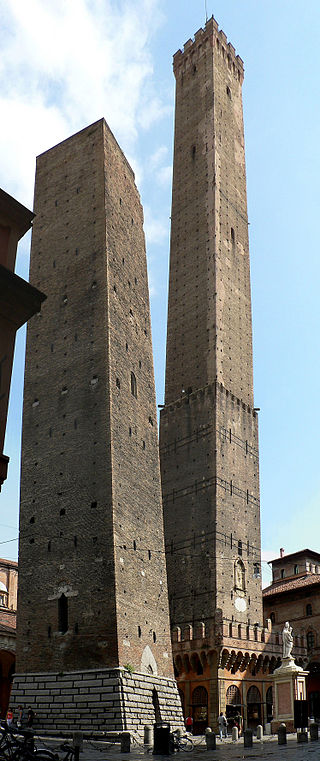
The Two Towers, both of them leaning, are the symbol of Bologna, Italy, and the most prominent of the Towers of Bologna. They are located at the intersection of the roads that lead to the five gates of the old ring wall. The taller one is called the Asinelli while the smaller but more leaning tower is called the Garisenda. Their names derive from the families which are traditionally credited with having constructed the towers between 1109 and 1119.

Bugnara is a comune and village in the province of L'Aquila in the Abruzzo region of central Italy. In 2007, it was designated as one of the most beautiful villages in Italy, an association that notes small Italian towns of artistic and historical interest.
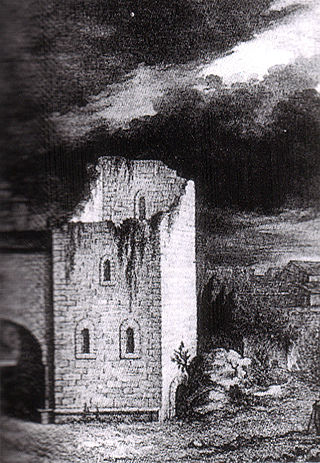
The Torre dei Gualandi is a former tower in Pisa, central Italy, now included in the Palazzo dell'Orologio.

The Towers of Bologna are a group of medieval structures in Bologna, Italy. The two most prominent ones remaining, known as the Two Towers, are a landmark of the city.
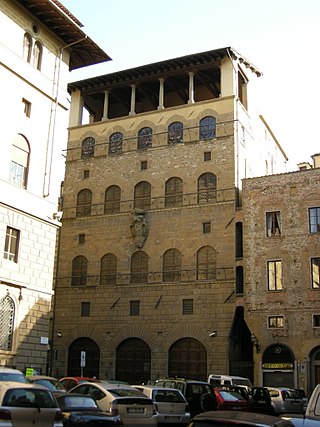
Palazzo Davanzati is a palace in Florence, Italy. It houses the Museum of the Old Florentine House.
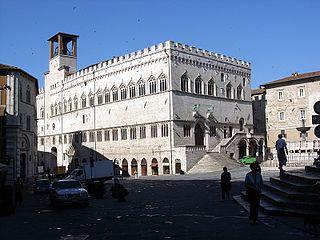
The Palazzo dei Priori or comunale is one of the best examples in Italy of a public palace from the communal era. It is located in the central Piazza IV Novembre in Perugia, Umbria. It extends along Corso Vannucci up to Via Boncambi. It still houses part of the municipality, and, on the third floor, the Galleria Nazionale dell'Umbria. It takes its name from the Priori, the highest political authority governing the city in the medieval era.
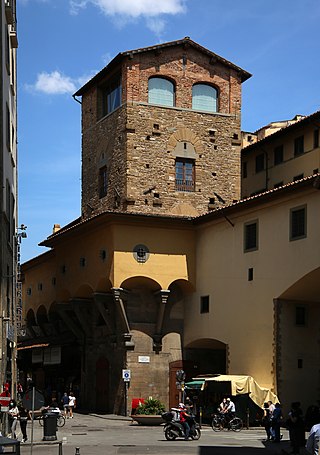
The Torre dei Mannelli is a small tower on the southeast corner of the Ponte Vecchio bridge in Florence, Italy. It is the only survivor of the four towers that once defended each corner of the bridge. In 1565, the Mannelli family refused to have it altered or demolished so that the Vasari Corridor could be built in a straight line. Instead the corridor swerved round it on brackets.

The Torre del Gallo is a historical building located in Florence, Italy, located at Pian de' Giullari, in the hills of Arcetri, on top of a ridge overlooking the city where there is a magnificent panorama.
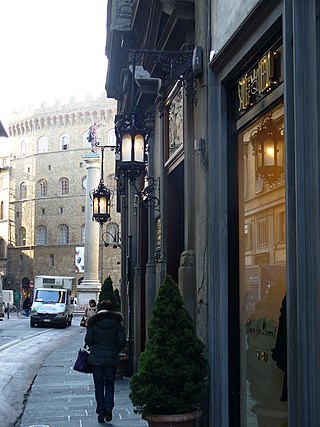
Via de' Tornabuoni, or Via Tornabuoni, is a street at the center of Florence, Italy, that goes from Antinori square to ponte Santa Trinita, across Santa Trinita square, distinguished by the presence of fashion boutiques.

Piazza del Duomo is located in the heart of the historic center of Florence. It is one of the most visited places in Europe and the world and in Florence, the most visited area of the city. The square contains Florence Cathedral with the Cupola del Brunelleschi, the Giotto's Campanile, the Florence Baptistery, the Loggia del Bigallo, the Opera del Duomo Museum, and the Arcivescovile and Canonici's palace. The west zone of this square is called Piazza San Giovanni.

Piazza della Cisterna is a piazza in San Gimignano, Italy. It has a triangular shape with a slight natural slope and is connected to the nearby Piazza del Duomo by an open passage. The pavement is brick and the piazza is surrounded by houses and medieval towers.
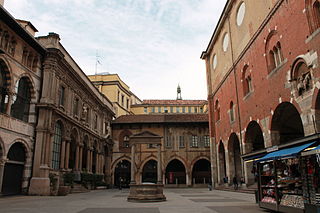
Piazza Mercanti is a central city square of Milan, Italy. It is located between Piazza del Duomo, which marks the centre of the modern city of Milan, and Piazza Cordusio, and it used to be the heart of the city in the Middle Ages. At the time, the square was larger than it is now and known as "Piazza del Broletto", after the "Broletto Nuovo", the palace that occupied the centre of the square. In the 13th century, there were six entry points to the square, each associated to a specific trade, from sword blacksmiths to hat makers.
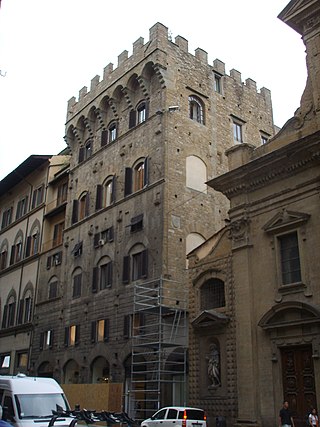
The Torre dei Gianfigliazzi is a Romanesque-style medieval tower-residence located on Via de' Tornabuoni #1 in central Florence, region of Tuscany, Italy. It can be seen rising adjacent to the left of the church of Santa Trinita. It now hosts a hotel.

The Torre degli Alberti is a XIII century medieval tower in Florence, Italy. It has a polygonal plan and was the headquarters and residence of the Alberti, one of the most numerous and powerful families in the medieval Florence.

The Torre degli Amidei is a tower in Florence, Italy. Dating from the upper Middle Ages, it is located near the Piazza della Signoria. Once located near the city's ancient walls, it belonged to the Amidei family, and, according to the tradition, was the alleged location of the killing of Buondelmonte de' Buondelmonti by one Amidei.
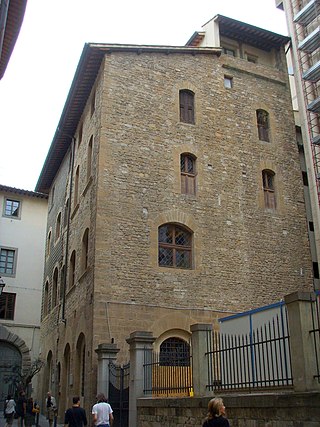
The Torre dei Pulci is a historical tower in Florence, Italy. The tower was the residence of the Pulci family in medieval and Renaissance times, including poet Luigi Pulci. It was in origin a purely defensive tower, which was enlarged until it became a sort of palazzetto or small residential palace.

Piazza dei Signori is a city square in Padua, region of Veneto, Italy. This piazza for centuries hosted official civic and government celebrations, while the larger squares of Piazza delle Erbe (herbs) and Piazza della Frutta (fruits) hosted commerce and public festive celebrations. The square is dominated by the famous Clock Tower.

The Palazzo Bartolini-Torrigiani is a palace located between Via Porta Rossa and Via delle Terme, in the city block just west of Piazza Santa Trinita that includes the Palazzo Bartolini Salimbeni, in the center of the city of Florence, region of Tuscany, Italy. This portion of the block includes the medieval Torre dei Monaldi, also known as della Rognosa, rising along Via Porta Rossa.

The Visconti Castle of Legnano is a mediaeval castle, located south of the city of Legnano, Metropolitan City of Milan, Lombardy, northern Italy. It lies on a small island formed by the Olona river. Since the 13th century, it is also known as the castle of San Giorgio.

Characteristic of the historic center of Pavia is the presence of medieval noble towers that survive in its urban fabric, despite having once been more numerous, as evidenced by the sixteenth-century representation of the city frescoed in the church of San Teodoro. They were mostly built between the 11th and 13th centuries when the Ghibelline city was at the height of its Romanesque flowering.





















